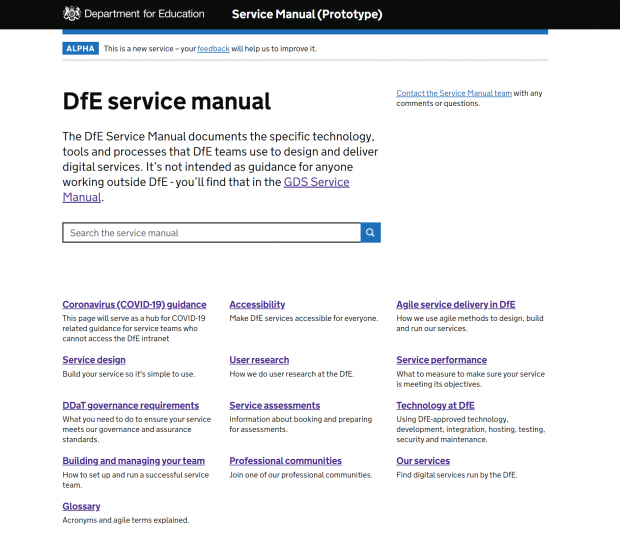
As the number of DfE services grow, so does the need for clear DfE specific guidance for our service teams to help them build great public services. To meet this need our team has been developing a DfE Service Manual.
We've just finished our alpha and in this post we'll share our findings so far.
Why DfE needs its own service manual
A service manual is a source of information that helps people across government build better public services that meet the Service Standard.
Service teams in DfE currently use the GDS Service Manual for guidance on how to build government services. But there is also DfE-specific information that they need to do things like managing risk, ensuring service security, hiring people, buying things, choosing digital tools, and using common components.
Our service teams struggle to get this information because it’s often stored in several places, like our intranet, Microsoft Teams, and Google Drive.
We wanted to create a single source of information for service owners and service teams.
To do this, we gathered content from different directorates such as Digital, Data, and Technology. We're also engaging with service owners and their teams to learn more about the work they do, how they find information, and what 'good' should look like.
Our service manual will not replace the GDS Service Manual but where content is broader and not DfE-specific, we'll link out to it. Other government departments, including NHS Digital, have also done this with their own service manuals and it works well.
Remote user research and analysis
Our alpha coincided with the beginning of the UK lockdown in response to the coronavirus outbreak. So our research had to be done remotely.
We had two ways of organising the information we wanted to test. Our first structure was cloned from the GDS Service Manual, the second focussed more on task-based content, for example how to set up and run a successful service team.
To test these two structures, we used ‘Optimal Workshop’ to create a ‘Treejack’ study. Optimal Workshop is a piece of software which has research tools to improve user experience. Treejack enables you to evaluate how easy it is for users to find information within a structure. This meant we could track the journey users took to find pieces of information.
This was combined with remote interviews, and asking users to score pages based on confidence, clarity, and tone. We started with content pages about how DfE is organised, and our recruitment, procurement, and tools.
What we’ve learned
Neither of the structures we tested were intuitive for users. There were high percentages of ‘indirectness’, meaning that users frequently backtracked through the structures. In one case this happened to 33% of users.
Even when participants had navigated to an incorrect location within the manual’s structures, they reported that they were highly confident they had navigated to the correct location.
We could see our existing content did not completely meet our users’ needs. They wanted more practical information, such as templates, pieces of content they could reuse, and contact details. They also wanted to be able to navigate through to further information if they needed it.
In addition, our research participants were concerned about duplicating content that was already in the GDS Service Manual. This was because we'd used a similar structure. In response to this we made it clearer on the homepage why the DfE Service Manual is different.
What’s next
We'll be moving into our beta phase in mid-June to do more remote research on what the structure of the DfE Service Manual should look like.
To do this, we'll use remote software to conduct open and closed card sorting exercises. Open card sorting will help us to understand how users group information, categories and topics.
A new structure for the manual will be proposed based on the categories users suggest. We'll test this through a closed card sort - we'll give users pre-set categories to put cards into.
Alongside this there'll be more remote interviews to further understand the needs of our users. These will help us better understand our users’ daily tasks, responsibilities, and pain points.
The most exciting part of our beta is that we will be co-designing our content with two service teams to make sure it really meets their needs. We’re spending some time with them over the next few weeks to get to know them better.
If you are part of a DfE service team and would like to take part in research for our beta, please comment below or get in touch with us.
You can follow Erin Bramwell and Emily Culyer on Twitter.
Subscribe to this blog.
2 comments
Comment by Luke Slowen posted on
Great work, well done team!
Comment by Dylan Green posted on
Hi,
I work for a private sector company and I'm trying to encourage them to adopt something like the GDS framework. I'm keen to look at how various organisations have adapted it - would you be able to include me in any study please? I wouldnt expect any support etc - I'm just seeing how I can adapt the framework to suit the company that I'm working with.